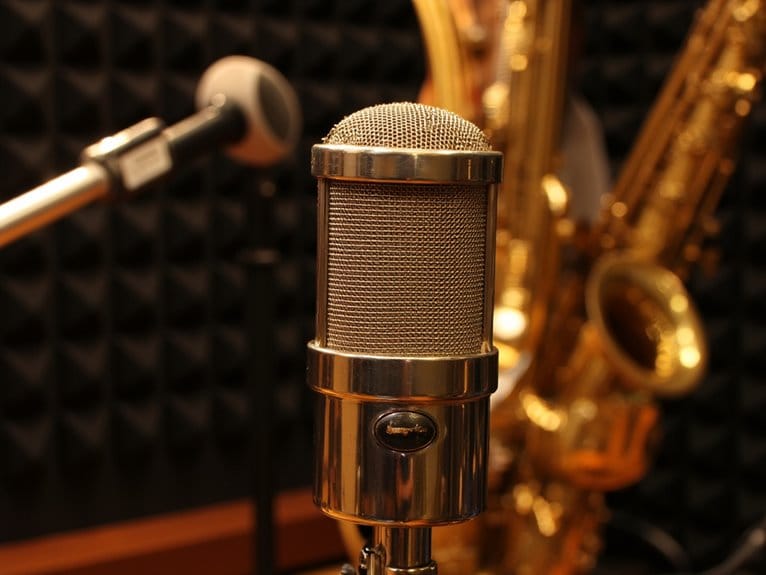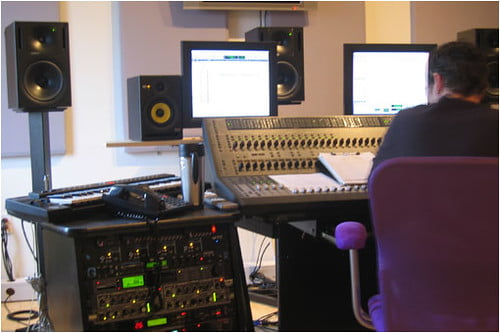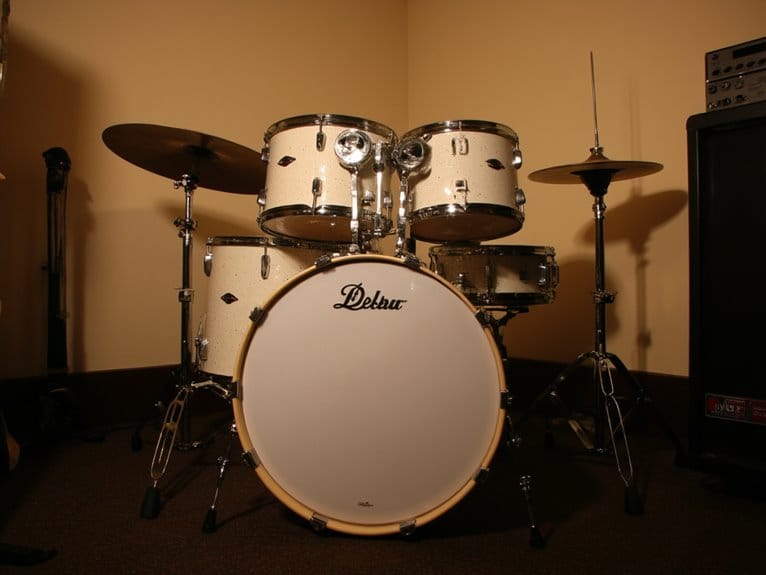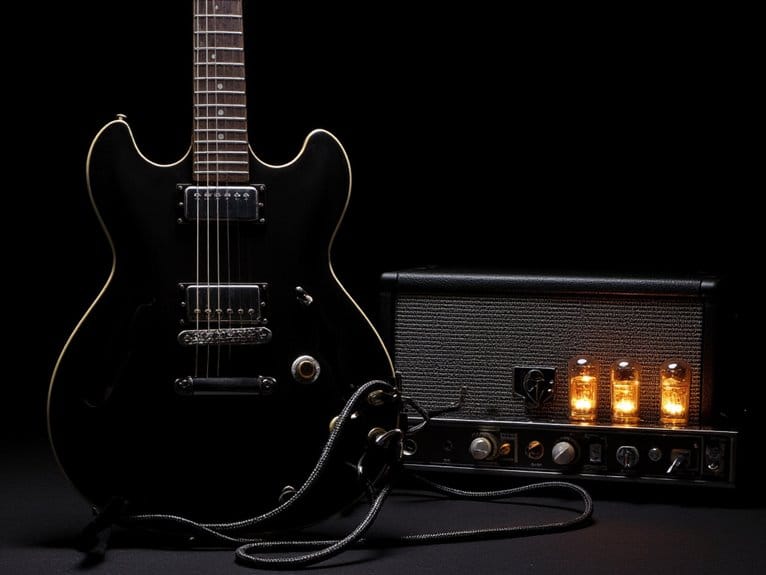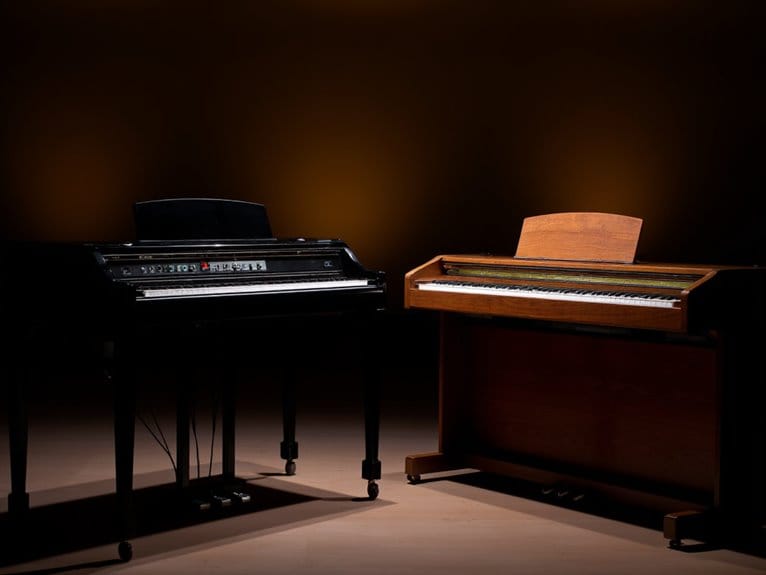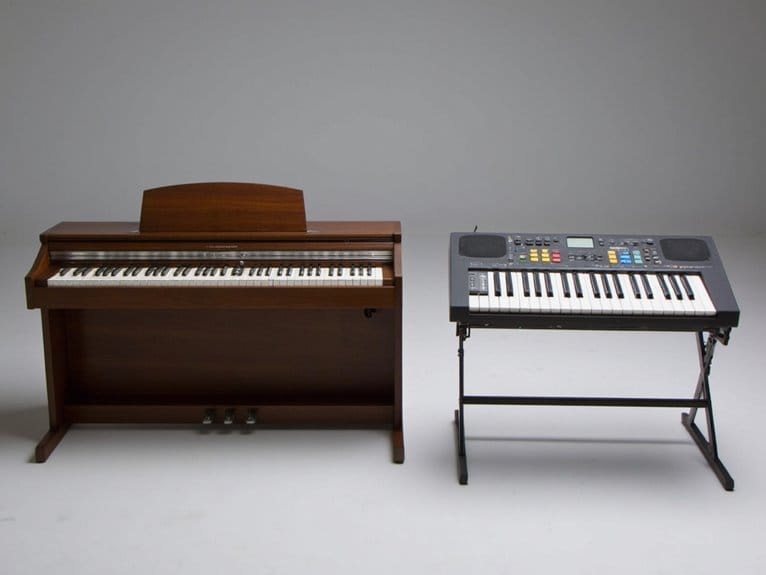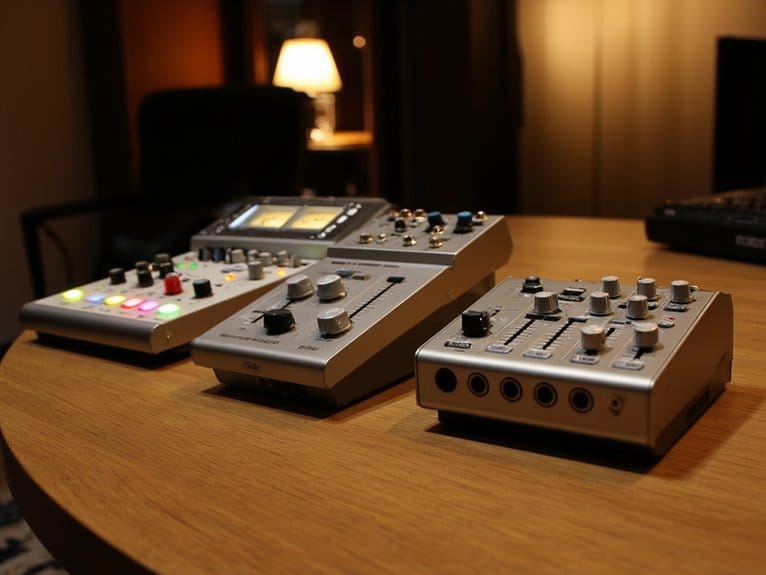What Are Ribbon Microphones Best Used for
Ribbon microphones excel at capturing vocals, brass instruments, and acoustic sources with natural warmth and vintage character that condensers often can’t match. You’ll find their figure-8 polar pattern and high-frequency roll-off particularly effective for taming harsh sibilance in vocals, smoothing aggressive brass tones, and adding organic depth to acoustic guitars and piano recordings. Their ability to handle high SPLs while maintaining spatial authenticity makes them invaluable for drum overheads and choir work, where you need both direct sound and room ambiance captured with exceptional detail and nuanced tonal complexity that reveals why seasoned engineers consistently choose them for specific applications.
We are supported by our audience. When you purchase through links on our site, we may earn an affiliate commission, at no extra cost for you. Learn more.
Notable Insights
- Natural vocal recording with warm tone and reduced sibilance, especially effective for jazz, blues, and voice-over work
- Instrumental recording that captures organic character of brass, strings, woodwinds, and acoustic guitars without artificial brightness
- Drum overhead recording using stereo configurations that provide exceptional spatial depth and tame harsh cymbal crashes
- Room ambiance capture through figure-8 polar pattern that balances direct sound with natural acoustic reflections
- Live performance applications with superior feedback rejection and high SPL handling for guitar amps and vocals
Natural Sound Capture and Human Auditory Perception
When I first started working with ribbon microphones in professional studios, I quickly discovered why engineers consistently reach for them when they want recordings that mirror what you’d actually hear standing in the room.
These microphones excel at natural sound reproduction, capturing audio with the same warmth and presence your ears would perceive during a live performance.
What sets ribbons apart is their wide, flat frequency response, which means they don’t artificially color the sound like some other microphone types do.
Their natural high-frequency roll-off eliminates harsh sibilance and aggressive top-end frequencies that can sound unnatural to human auditory perception, while their figure-of-8 polar pattern captures both the direct instrument sound and the room’s ambient characteristics, creating realistic, immersive soundscapes.
The ribbon’s ability to handle high sound pressure levels without distortion makes them particularly valuable when recording loud instruments while maintaining that natural, uncolored tone that defines professional recordings.
The thin metal ribbon suspended within the magnetic field responds to sound waves with remarkable sensitivity, which explains why these microphones can achieve such detailed and nuanced recordings that rival the performance of condenser microphones.
This versatility makes ribbon mics particularly beneficial for home studio enthusiasts seeking warm sound for recordings across diverse genres, including folk and classical music.
Recording Vocals With Warmth and Vintage Character
While that natural sound reproduction makes ribbon microphones exceptional for capturing realistic audio, their most celebrated application lies in vocal recording, where they transform ordinary performances into something with unmistakable warmth and vintage character.
You’ll notice ribbon mics enhance low-end frequencies through their proximity effect, adding incredible depth when you position them close to vocalists. Their figure-8 pickup pattern works brilliantly for vocal layering sessions, capturing two performers simultaneously while rejecting off-axis noise. Strategic microphone placement becomes essential since ribbons naturally roll off harsh high frequencies, delivering that smooth, warm tone reminiscent of classic recordings.
However, vocal applications require additional pop filters to protect against plosives that can damage the delicate ribbon element. Ribbon microphones produce less colored sound reproduction compared to dynamic mics, making them ideal for capturing the authentic character of vocal performances. Unlike condenser microphones that may capture unwanted ambient noise due to their high sensitivity, ribbon mics provide better isolation in untreated recording spaces.
| Vocal Application | Key Benefit | Best Use Case |
|---|---|---|
| Solo recording | Natural warmth | Jazz, blues vocals |
| Duet capture | Bi-directional pattern | Interviews, harmonies |
| Voice-over work | Reduced sibilance | Broadcasting |
| Vintage reproduction | Frequency roll-off | Classic sound recreation |
| Ambient recording | Room integration | Live performance capture |
Brass Instruments – Taming Harshness and Adding Warmth
Though brass instruments can deliver some of the most powerful and expressive sounds in music, they’re also notorious for producing harsh, piercing frequencies that’ll make your ears ring and your mix sound aggressive.
Ribbon mics naturally roll off those problematic high frequencies, effectively addressing brass harshness without completely dulling the instrument’s character.
You’ll find they tame those shrill trumpet peaks and trombone honks that can overpower your mix, while their midrange emphasis provides exceptional warmth enhancement that brings out the natural weight and tonal color of brass instruments.
The proximity effect adds even more depth when you’re close-miking, and their ability to handle high SPLs means you won’t get distortion even during the most vigorous performances. Their figure-of-8 polar pattern captures sound from both the front and back of the microphone, making them versatile for various recording scenarios. This sound authenticity directly influences your listener’s perception and connects them more deeply to the musical performance.
Acoustic Guitars and String Instruments
When you’re recording acoustic guitars and string instruments, you’ll discover that ribbon microphones offer something truly special—a natural warmth that captures the organic character of these instruments without the artificial brightness that condensers often impose.
I’ve found that proper positioning, typically 12 to 24 inches from the guitar and aimed toward the 12th fret, allows you to harness the ribbon’s figure-of-8 polar pattern for both balanced tone capture and effective isolation from unwanted sounds like vocals.
The technique becomes even more powerful when you understand how these mics enhance the low-end presence and midrange punch that gives acoustic guitars their fullness, while their bi-directional pattern captures room ambience that adds that coveted spacious, cinematic quality to your recordings. For singer-songwriter applications, you can position one ribbon mic with its null planes toward the vocalist’s mouth while capturing the guitar, effectively reducing bleed between the two sources. When using stereo ribbon configurations, positioning at the neck-body joint creates excellent stereo imaging while maintaining the natural character that makes ribbons so sought after for acoustic recordings.
Natural Warmth Capture
The inherent character of ribbon microphones makes them exceptionally well-suited for capturing acoustic guitars and string instruments, where their natural warmth can transform potentially harsh or edgy recordings into something genuinely musical.
You’ll find that ribbons excel at taming those aggressive high frequencies that can make string instruments sound brittle, instead delivering soft tonalities that preserve the instrument’s organic character.
Their smooth frequency response naturally rolls off harsh overtones while maintaining excellent dynamic range, allowing delicate fingerpicking passages and aggressive strumming to coexist beautifully.
The low-end extension these mics provide adds substantial body to acoustic guitars, creating that full-bodied sound that sits perfectly in any mix without requiring extensive EQ manipulation. However, ribbons are less effective for acoustic guitar when capturing fine detail and nuance is the primary goal, as condensers typically excel in those specific applications. The figure-of-8 polar pattern also provides exceptional rejection of unwanted ambient noise, allowing you to capture pure instrument tone even in less-than-ideal recording environments.
Positioning and Technique
Proper positioning becomes absolutely critical when you’re working with ribbon microphones on acoustic guitars and string instruments, since these sensitive transducers can dramatically transform your recording based on subtle placement changes of just a few inches.
I’ve found that ideal mic placement sits around 12-24 inches from the 12th fret, where you’ll capture balanced tonal variations without excessive low-end resonance. The figure-8 polar pattern offers excellent acoustic isolation opportunities—position the null points strategically to reject unwanted bleed.
For enhanced audio precision, try a dual mic setup with complementary orientations. Proximity adjustments affect instrument resonance capture considerably, while angling slightly away from the sound hole prevents boominess.
These recording techniques create a natural sound stage that reveals your guitar’s authentic character.
Drum Overheads and Full Kit Recording
When you position ribbon microphones as drum overheads, you’re revealing their exceptional ability to capture spatial depth that extends far beyond the kit itself, creating recordings that breathe with natural room ambience and three-dimensional presence.
Your stereo pair configuration becomes critical here, whether you choose the classic Blumlein technique with crossed figure-8 patterns or opt for spaced pairs that emphasize timing differences, since these placement decisions directly impact how listeners perceive the kit’s width and positioning within the mix.
The tonal complexity enhancement that ribbons provide transforms harsh cymbal crashes into smooth, musical textures while maintaining the weight and punch of your drums, giving you that coveted vintage warmth that modern producers often struggle to achieve with condenser microphones alone. While dynamic microphones excel at capturing individual drum elements like floor toms, ribbons offer superior room capture for full kit recording scenarios.
To maximize the stereo imaging benefits, position your ribbon overheads at the optimal 24-40 inch height range above the cymbals while maintaining equal distances from both the snare and kick drum to prevent phase cancellation issues.
Spatial Depth Capture
Although I’ve worked with countless microphones over the years, ribbon mics consistently surprise me with their ability to capture spatial depth in drum recordings that other microphones simply can’t match.
Their figure-8 polar pattern creates exceptional spectral imaging by simultaneously capturing direct drum sounds and room reflections, while the natural high-frequency roll-off prevents cymbal harshness from overwhelming your acoustic layering.
You’ll notice how ribbons blend kit elements with ambient space, creating dimensionality that feels three-dimensional rather than flat.
Here’s what makes ribbon mics excel at spatial depth capture:
- Bidirectional pattern captures both close and ambient sounds naturally
- Smooth frequency response prevents brightness from masking spatial cues
- Room reflection sensitivity enhances perception of depth and space
- Natural reverb preservation maintains organic spatial characteristics without artificial processing
Stereo Pair Configuration
Building on this spatial awareness, stereo pair configurations with ribbon microphones transform drum overhead recording from a simple cymbal-capture technique into a thorough approach that encompasses the entire kit’s sonic character.
You’ll discover that a Blumlein setup, utilizing matched ribbons at 90-degree angles, delivers exceptional stereo imaging while maintaining phase coherency that makes engineers weep tears of joy.
The figure-8 frequency response naturally tames harsh cymbal frequencies, creating warmer ambient capture that sounds less like tin cans in a blender.
Strategic mic placement exploits null points for unwanted noise rejection, while room interaction becomes your secret weapon for multi mic techniques that capture the kit’s complete personality, not just individual drum hits floating in sonic isolation.
Tonal Complexity Enhancement
Beyond the spatial benefits of stereo placement, ribbon microphones reveal tonal complexity that transforms drum overhead recording into an art form where harsh cymbal crashes become musical elements within a cohesive sonic landscape.
You’ll discover that ribbons naturally tame high-frequency shrillness while preserving cymbal articulation, creating a more musical listening experience that won’t fatigue your ears during long sessions. Their figure-8 pattern captures room reflections alongside direct sound, expanding your sound stage with dimensional depth that condenser mics often miss.
Here’s how ribbon mics enhance tonal complexity:
- Proximity effect adds warmth – positioning closer enriches low-end body without muddiness
- Natural high-frequency roll-off – reduces cymbal harshness while maintaining clarity
- Room ambience integration – blends direct kit sounds with acoustic reflections seamlessly
- Enhanced tonal balance – provides fuller midrange presence for cohesive drum sound
Woodwind Instruments and Natural Tonal Reproduction
When I first started recording woodwind instruments decades ago, I quickly discovered that ribbon microphones possess an almost magical ability to capture the warmest, most natural sound compared to condenser or dynamic alternatives, thanks to their inherent high-frequency roll-off and figure-of-8 polar pattern that replicates how we actually hear these instruments in real acoustic spaces.
The microphone sensitivity of ribbons naturally complements woodwind dynamics, preserving subtle tonal nuances without artificial brightness that can plague clarinets and saxophones. I’ve found positioning the mic about 16 inches over the bell while angling toward tone holes captures the full spectrum beautifully.
| Feature | Benefit |
|---|---|
| Natural frequency roll-off | Eliminates harsh highs |
| Figure-8 polar pattern | Reduces off-axis noise |
| Extended low-end response | Preserves woodwind warmth |
Piano Recording and Choir Overheads
When you’re recording piano or positioning choir overheads, you’ll find that ribbon microphones offer unique advantages that I’ve consistently relied on throughout my years behind the console.
The figure-8 polar pattern naturally captures both the direct source and controlled room reflections, which means you can achieve that coveted balance between intimate detail and spatial depth without wrestling with multiple microphone types.
Whether you’re placing ribbons above piano hammers to catch those transient attacks or suspending them over a choir to capture the ensemble’s collective warmth, the key lies in understanding how distance affects your stereo image and room integration.
Piano Placement Techniques
The art of capturing piano with ribbon microphones demands a nuanced understanding of placement techniques that’ll transform your recordings from ordinary to extraordinary.
Piano resonance becomes your ally when you position ribbons strategically, while mic distance determines whether you’ll capture intimate detail or expansive room character.
Here’s how I approach ribbon mic piano placement:
- Close stereo positioning – Place two ribbons about one foot from each side of the strings for balanced tonal capture.
- Blumlein array technique – Position figure-8 ribbons 1-3 feet from the piano, centered at middle C for natural stereo imaging.
- Behind-the-hammers placement – Mount one ribbon above and behind hammers to mimic the player’s sonic perspective.
- Ambient room capture – Pull mics back 2-3 feet to include reflective acoustics while maintaining essential detail.
Choir Spatial Capture
Moving beyond individual piano capture, ribbon microphones reveal their true spatial prowess when you’re recording choir ensembles, where their figure-8 polar pattern becomes your secret weapon for capturing both the direct vocal energy and the natural acoustics that surround it.
You’ll want to position your ribbon mics 6-10 feet from the choir, allowing the bi-directional pickup to capture room reflections alongside the direct sound, which creates that immersive choir acoustic that makes listeners feel they’re sitting in the concert hall.
The natural off-axis response helps blend individual voices seamlessly, maintaining ensemble dynamics without harsh frequencies that can make choral textures sound brittle or unnatural in your final mix.
Room Ambience Balance
Something magical happens when you’re capturing room ambience balance with ribbon microphones, whether you’re recording piano or setting up choir overheads.
These mics excel at creating that perfect marriage between direct instrument sound and natural room acoustics.
Your microphone choice dramatically affects how much room sound you’ll capture, and ribbons naturally blend instrument detail with spatial characteristics.
I’ve found that their bi-directional pickup pattern captures both direct sound and reflected ambience, creating depth without overwhelming the primary source.
- Position ribbons 6-12 feet from piano for ideal room/instrument balance
- Use Blumlein pair configuration for enhanced stereo imaging and spatial width
- Leverage natural high-frequency roll-off to reduce harsh reflections
- Strategic placement minimizes proximity effect while maximizing soundstage enhancement
Frequently Asked Questions
How Much Do Quality Ribbon Microphones Typically Cost Compared to Condenser Mics?
You’ll find quality ribbon microphones typically start around $500-600, while entry-level condensers can cost under $100, making budget considerations essential when comparing these microphone types.
I’ve noticed mid-tier ribbons often range $500-2,000, whereas comparable condensers cost $200-1,000.
High-end ribbons frequently exceed $3,000 due to their delicate construction, specialized manufacturing processes, and niche market positioning, though premium condensers can reach similar prices.
Can Ribbon Microphones Be Permanently Damaged by Phantom Power or Loud Sounds?
Yes, phantom power can permanently destroy ribbon microphones, particularly passive models, since the electrical surge damages the delicate ribbon element inside.
Loud sounds rarely cause damage though – modern ribbons handle typical studio sound pressure levels without issue, and you’d need extremely loud sources like kick drums at close range to harm them through excessive vibration.
What Preamp Gain Requirements Do Ribbon Mics Have for Optimal Performance?
For ideal performance, you’ll need preamp types that deliver at least 65 dB of clean gain since passive ribbons are inherently low-output devices.
Most standard interface preamps fall short at 45-65 dB, requiring dedicated ribbon preamps with 81+ dB capability.
Proper gain staging becomes essential because pushing insufficient preamps beyond their limits introduces unwanted noise and hiss, while high-impedance inputs preserve the ribbon’s natural frequency response.
On a final note
You’ll find ribbon microphones excel when you’re chasing that natural, vintage warmth that dynamic and condenser mics simply can’t deliver. Whether you’re recording vocals, brass instruments, acoustic guitars, or drum overheads, their smooth frequency response and figure-8 polar pattern offer unique advantages. While they’re more delicate than other mic types, I’d argue they’re essential for capturing the organic character that makes recordings feel alive and musical.

